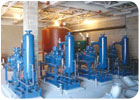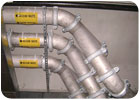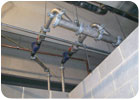
The California Gold Rush in the mid-1800s helped define a significant part of the culture on the American Frontier. At a time when currency was based on the gold standard, the newly mined gold provided an economic stimulus all across the North American continent. Despite the economic benefits, there were associated risks that caused many people to limit, or even avoid, participating. Nevertheless, many who accepted the risks and ventured down dusty trails benefited from their decision.
In the world of plumbing design, vacuum is the next frontier. Those with little knowledge of, or experience with, vacuum plumbing systems (VPS) may be like those who viewed the Gold Rush too risky. Most plumbing designers and engineers are comfortable with traditional DWV systems and see no reason to consider an alternative and certainly would not consider vacuum a pot of gold! However, as water shortages increase across the U.S., alternative approaches to traditional thinking must be considered.
As the U.S. population increases, higher demands for fresh water are becoming paramount environmental concerns. The EPA recently reported that water managers in 36 states anticipate water shortages in the next 10 years even under normal water conditions. In numerous areas where water wells are used for public-supply systems, subsidence due to over pumping is becoming critical. The chart shown in Figure 1 identifies monthly-mean water levels from 1964 to 2003 for a USGS monitored water well in Cook County, GA. This chart clearly illustrates the long-term effects of over pumping of groundwater aquifers.

Part of a Permanent Solution
High-performance, water-conserving systems like vacuum plumbing systems may be a significant part of the permanent solution for water shortages. VPS utilize a specially designed toilet that uses nearly 70% less water than a conventional toilet. Conventional toilets (that comply with the 1992 EPACT standards) use 1.6 gpf, while vacuum toilets use 0.50 gpf.For projects requiring LEED certification, several credits may be obtained by using a VPS due to the reduced flush rates. After calculating the project’s base load case, the designer should evaluate the possibility of obtaining Water Efficiency Credits WE 2, 3.1 and 3.2. Vacuum will reduce the generation of wastewater and potable water demand. It also will maximize water efficiency within buildings to reduce the burden on municipal water supply and waste water systems. Also, Innovation & Design Process Credit ID 1 may be obtainable due to performance of the vacuum system above the minimum required by the LEED rating system.
Another benefit of VPS is its resistance to stoppages. While not completely clog-proof, the VPS consistently out-performs traditional systems in this regard. This is especially helpful in jails and prisons where inmates have been known to disrupt security operations by intentionally clogging water closets and even breeching the entire sanitary piping system by flushing clothing, bedding, or other items down the toilet.
Even if your project scope doesn’t include LEED certification, green design, or security issues, other reasons exist to consider VPS. Some projects have specific architectural limitations, like floor slabs that cannot be penetrated for sanitary piping or buildings without chases, where conventional plumbing systems are difficult to install. VPS piping is typically installed overhead, so projects with limited chase space or other architectural limitations may be perfect candidates for a vacuum system.
VPS can be used in a variety of applications, including office buildings, hospitals/clinics, hotels, restaurants, retail stores and shopping centers, schools, sporting arenas, correctional facilities, and detention centers. Additionally, one wide use of VPS is in the removal of condensate water from refrigeration units, food display cases, and walk-in coolers in food courts and grocery stores.

Once feasibility issues are resolved, certain design issues must also be addressed. For many years, plumbing load estimation and basic DWV design has been based on the prescriptive guidelines developed by Dr. Roy B. Hunter in the BMS 65 Report (National Bureau of Standards, December 16, 1940). However, at this point in time, there is no similar universally recognized approach for the design of VPS. This fact requires VPS design to be performed under the Code provisions of an engineered system.
The International Plumbing Code (IPC) allows and addresses such systems in Section 105.4, Alternative Engineered Design (2006 IPC). While manufacturers typically offer design guidelines, recommendations and support, the VPS design is solely the responsibility of the designer. So, as with any engineered type system, a level of design effort beyond conventional DWV systems is required. Therefore, one must apply specific scientific and technical knowledge for the design, analysis, and construction of vacuum systems.
Before including a VPS into a project, you must advise your client of several important issues from the onset. The first is that VPS are an evolving technology and, as a result, some with VPS experience may not have favorable opinions. Originally used in plumbing systems in aircraft, trains and boats, several of the first building-based projects were plagued with performance issues. Due to a continued commitment in the R&D of VPS from U.S.-based manufacturers, most of the initial problematic issues have been overcome.
The second issue to educate your client about is the benefits of investing in an engineered system. The client must be reminded that engineered systems which perform properly and are reliable are those that are properly designed, installed and maintained. Due to differing approaches to VPS technology, the owner may be best served with vacuum components provided from a sole source manufacturer. Therefore, the designer must establish appropriate procurement processes accordingly.
Finally, as with any mechanical system that operates properly, the owner must be willing to make a commitment over the life of the system to maintenance. The VPS will require different maintenance than a typical DWV system because it includes pumps, controls and components that may require periodic replacement and/or adjustment.

Administrative and Engineering Tasks
As the project design progresses, several administrative and engineering tasks are recommended. The designer should:


Regardless of any previous ideas or knowledge of VPS, consulting engineers and designers must consider this new technology. Make your own decision, consider the cost and remember the benefits may outweigh the risks and the gains may be too great to ignore. After all, that’s how the West was won!
Western Virginia Jail Features VPS
The Western Virginia Regional Jail is one the first major projects on the east coast to use a VPS and is likely to be the first LEED-certified jail facility in the U.S. With such bold initiatives, it was imperative to use systems that could assist in achieving the required LEED credits.
Plumbing Systems